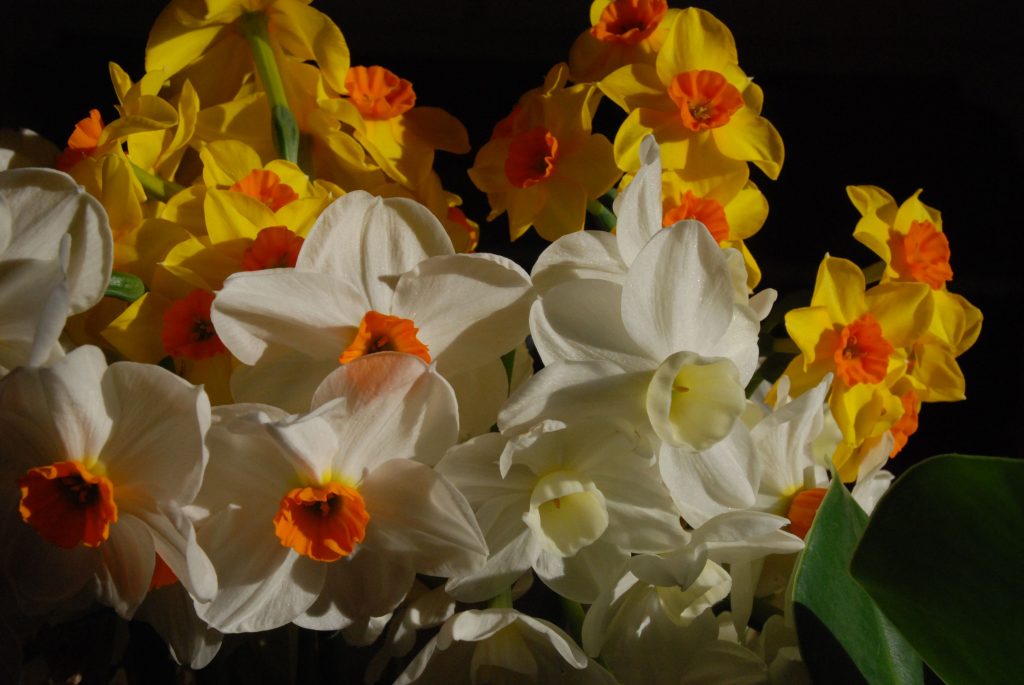
There can be few gardens that do not contain at least a few daffodils – they must be our favourite flowers. And no wonder; they are long-lived and provide the first real splash of colour in spring.
When I started this new garden it contained nothing but grass – not a tree, shrub or flower – so the first things I planted, apart from hedges and some trees, was daffodils. Along the roadsides and in other gardens there are masses of golden daffodils and I needed some – desperately.
A simple bunch of yellow daffs is an uplifting sight but there is a lot more to daffodils than just yellow flowers. For a start, there are old-fashioned varieties that provide a link with the past and there are showy, modern kinds that offer a peak of perfection unimaginable a century ago. When our family moved to Surrey we lived in Lingfield before Oxted and the old and neglected garden was packed with ancient daffodils including the quirky ‘Van Sion’ with trumpets packed with petals – now, fortunately, quite commonly for sale – look for it in autumn. I have been planting lots of daffodils – more than 100 varieties – in the garden, but those I am most excited about are the old, heritage varieties. Their flowers are small and have thin petals but I love the fact that they are living links with the past – and their perfume takes me back to my childhood.

Daffodils look best in grass. But not all look good when naturalised. The older, smaller and simpler kinds look best when planted in grass and some of the modern kinds can look a bit strange. But you can choose whichever you like best. I have planted pink and white daffodils along the drive – taking care that no yellow daffodil ruins the pastel effect!

Because different varieties flower over many months, it is always best to plant one or two varieties together and not a mixed bag, which gives a spotty effect.
Remember that daffodils tolerate a little shade but they are not woodland plants and they will not bloom prolifically if they do not get enough light. And when planting in grass bear in mind that you should not cut the leaves off until at least six weeks after the flowers fade, to allow the bulbs to strengthen and bloom the following year. Deadheading is beneficial but if you have thousands in a meadow it is not absolutely vital.

Remember also that daffodils turn, in bud, to face the light, so planting against a dark background ensures they all face the right way!
The dying foliage can be a nuisance but you must not tie it in knots or cut it off too early. I have them planted in borders, among other plants such as peonies, hardy geraniums and daylilies which disguise the daffodil leaves.

And I have others planted under fruit trees, especially to provide cut flowers. I like the tazetta kinds for cutting, with several small flowers per stem and rich, vibrant perfume.
Take a look around the garden and make a note of where you could add some daffodils this autumn so your garden is filled with colour and scent next spring.
Jobs for the week
Plant potatoes and onion sets – onions need planting soon though you have a few weeks to get the spuds in.
Sow herbs – For a good supply of parsley, sow now, on the windowsill. Parsley has a reputation for being slow to germinate but fresh seed has few problems – but a fresh pack each spring. You can sow dill, chervil and coriander too. Basil needs more warmth to grow so delay sowing for a few weeks.
Divide perennials – it is the last chance to dig up, divide and move any herbaceous plants.
Control weeds – hoe off annual weeds before they get too big.
Mow the lawn – set the blades high so you do not scalp the grass. Apply a lawn fertiliser in the next month